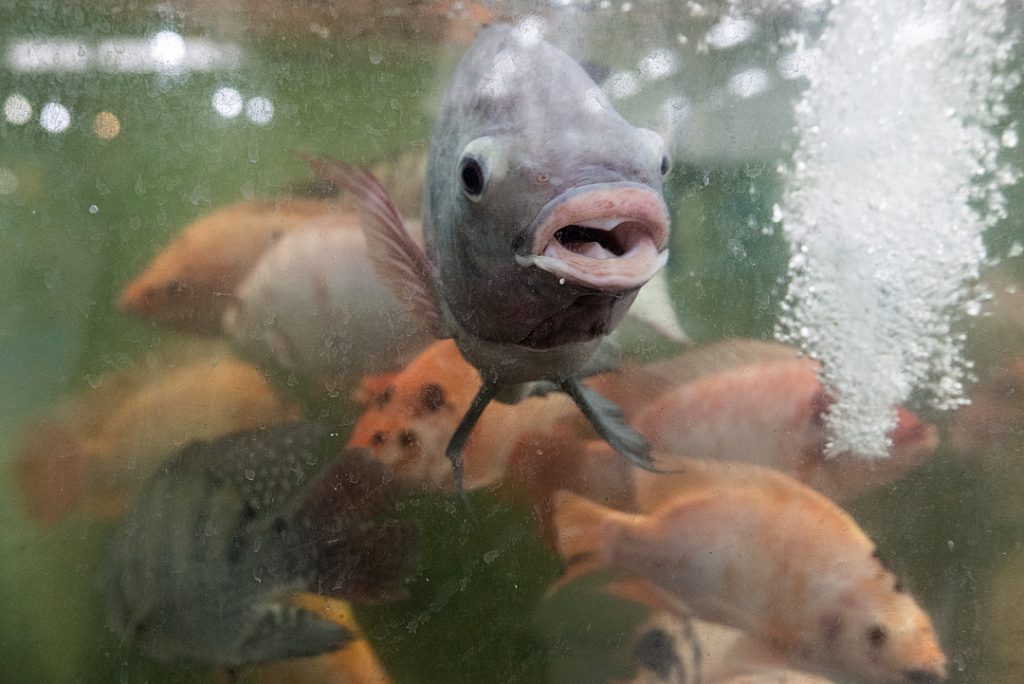Aquatic animals, including finfish and decapod crustaceans, are consumed as food in vast numbers and are often exposed to harsh farming conditions and inhumane deaths.

Fish Welfare
We work to improve conditions for hundreds of billions of aquatic animals.
Estimates suggest that 73 to 180 billion finfish are alive on farms at any given time (official statistics on fish don’t record individuals, but rather the tonnage of fish killed). Around 100 different finfish species are intensively farmed worldwide — and because aquatic species have been long neglected by welfare science, aquaculture companies have a limited understanding of how to raise and slaughter them in humane conditions. Fish often spend multiple years suffering on farms before they reach a harvestable size.

Wild-caught fish, of which 0.8 to 2.3 trillion are caught annually, are captured using methods that crush them in nets or painfully snag them on hooks, leaving them in excruciating pain. If fish do make it onboard a vessel alive, they frequently asphyxiate before reaching the shore or are slaughtered while still conscious, often with methods that leave them alive and suffering for an extended period.
And finfish aren’t the only aquatic animals suffering. More than 400 billion shrimps are alive on farms at any given time, as well as 30 to 56 billion crayfish, lobsters, and crabs. These invertebrates are often kept in crowded, oxygen-poor enclosures before being sold to consumers while still alive, or killed in slow, agonizing ways.

Thanks to the work of consumers, scientists and advocates, there is growing awareness of how fish and aquatic invertebrates are raised on farms or caught in the wild.
We support a variety of actors who are focused on understanding and improving the conditions of farmed fish and reducing some of the cruelest practices used to catch wild fish:
- Researchers are working to measure finfish brain activity, study their behavioral biology, and determine appropriate housing conditions.
- Scientists, engineers, and industry professionals are developing welfare-improving technologies to be deployed on farms and ships.
- Third-party certifiers of consumer products are beginning to incorporate evidence-based fish welfare content into their sustainability certification schemes.
- Advocates are working to secure corporate and legislative welfare reforms for aquatic animals.
Improved third-party certification requirements are on track to improve the lives of 4 to 10 billion fish on farms. These certifiers, along with researchers, advocates, and policymakers, are also exploring welfare protection for farmed decapod crustaceans. Advocates recently secured recognition for decapod crustaceans as sentient beings under UK law.
As the European Union revises its animal welfare laws, the European Food Safety Authority is set to produce a number of scientific opinions on key farmed finfish species like seabream, carp, and eels. Advocates are working to lay a strong foundation for future welfare protections during this process, including recommendations for pre-slaughter stunning, stocking density, and limits on handling times and techniques.
Many countries have limited welfare protections for farmed and captured aquatic animals, and some don’t even legally recognize members of these species as animals. We’ll continue supporting efforts to expand legislation in places where finfish and crustacean farming is most intensive, and to encourage retailers to improve the welfare of the aquatic animals in their supply chains. And as our scientific understanding of aquatic animal welfare improves, we’ll be even better equipped to reduce the suffering of trillions of animals around the world.
Fish Welfare, at a glance
-
50+ Grants
Made -
73 billion farmed fish
alive at any time